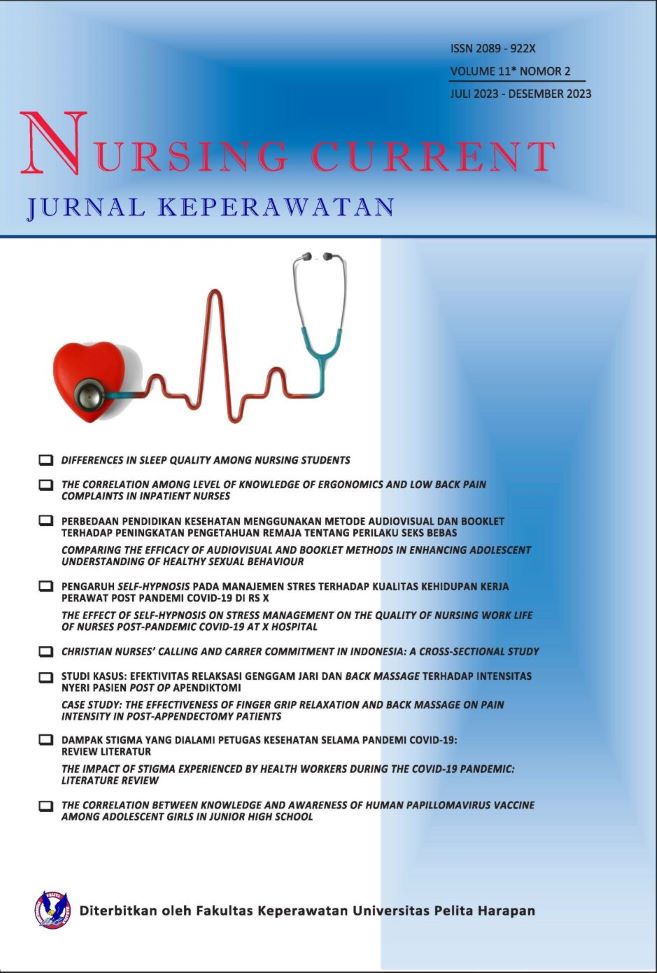THE CORRELATION AMONG LEVEL OF KNOWLEDGE ABOUT ERGONOMIC POSITION AND LOW BACK PAIN COMPLAINTS IN INPATIENT NURSES
DOI:
https://doi.org/10.19166/nc.v11i2.7281Kata Kunci:
ergonomics, ergonomics knowledge, low back pain, LBPAbstrak
Low Back Pain (LBP) is a collection of several clinical symptoms that are marked by pain or discomfort in the lower back, which may or may not extend to the legs. Incorrect ergonomics is the primary factor contributing to lower back pain (LBP) among nurses. The objective of this study was to establish a correlation between the extent of ergonomics knowledge and the occurrence of lower back pain (LBP) complaints among nurses who work with hospitalised patients. This study employed a correlational quantitative design, utilising a cross-sectional technique. The sample size for this study consisted of 158 nurses working in the inpatient unit of a private hospital in Indonesia. The sampling technique employed was a total sampling, resulting in a sample size of 158 nurses. The research employed questionnaires that were both valid and trustworthy. The questionnaires assessing knowledge of ergonomics were devised by Bunga et al. (2019), whilst the questionnaire pertaining to low back pain was formulated by Deria (2021). The findings of the Pearson chi-square statistical test indicated a p-value of 0.105, suggesting that there was no statistically significant association between the level of knowledge of ergonomics postures and complaints of low back pain among inpatient nurses. Inpatient nurses have the ability to discover and implement ergonomic postures in their regular tasks. Further research could be undertaken on the elements that can induce low back discomfort.Referensi
Allegri, M., Montella, S., Salici, F., Valente, A., Marchesini, M., Compagnone, C., Baciarello, M., Manferdini, M. E., & Fanelli, G. (2016). Mechanisms of low back pain: A guide for diagnosis and therapy. F1000Research, 5, 1530. https://doi.org/10.12688/f1000research.8105.2
Andini, F. (2015). Risk Factors of Low Back Pain in Workers. Medical Journal of Lampung University, 5(1), 12-19.
https://juke.kedokteran.unila.ac.id/index.php/majority/article/view/495
Astuti, R. P., Arifin, A. N., & Putro, P. D. (2022). Hubungan tingkat pengetahuan sikap kerja yang ergonomis terhadap nyeri punggung bawah pada supir bus di Yogyakarta [Doctoral dissertation, Universitas' Aisyiyah Yogyakarta]. http://digilib.unisayogya.ac.id/id/eprint/6521
Bunga, D. N. F. H. (2019). Pengembangan Model Perilaku Ergonomi Perawa dalam Pencegahan Kejadian Low Back Pain. [Doctoral dissertation, Universitas Airlangga]. https://repository.unair.ac.id/92820/
Deria, D. (2021). Hubungan Pengetahuan Posisi Ergonomi Terhadap Gangguan Muskuloskletal Pada Remaja Pembelajaran Daring Di Rengasdengklok Karawang tahun 2021. [Skrpisi, STIkes Medistra Indonesia]. http://erepository.stikesmedistraindonesia.ac.id/xmlui/handle/123456789/142
Dewi, W. S. (2017). Hubungan Tingkat Pengetahuan Perawat Tentang Posisi Ergonomi dengan Angka Kejadian Low Back Pain (LBP) Di RSUD Tarakan. [Doctoral dissertation, Universitas Binawan]. http://repository.binawan.ac.id/id/eprint/508
Dlungwane, T., Voce, A., & Knight, S. (2018). Prevalence and factors associated with low back pain among nurses at a regional hospital in KwaZulu-Natal, South Africa. Health SA Gesondheid, 23. https://doi.org/10.4102/hsag.v23i0.1082
Fatoni, H., & Swasti, K. G. (2012). Hubungan sikap dan posisi kerja dengan low back pain pada perawat di RSUD Purbalingga. Jurnal Keperawatan Soedirman, 7(2), 86-92. https://jks.fikes.unsoed.ac.id/index.php/jks/article/view/360/198
Gaowgzeh, R. A. (2019). Low back pain among nursing professionals in Jeddah, Saudi Arabia: Prevalence and risk factors. Journal of Back and Musculoskeletal Rehabilitation, 32(4), 555-560. https://doi.org/10.3233/bmr-181218
Hendrasari, T. T., Dharmmika, S., & Rachmi, A. (2017). Hubungan antara Pengetahuan Ergonomi dan Kebiasaan Posisi Belajar dengan Kejadian Nyeri Punggung Bawah. Prosiding Pendidikan Dokter. Prosiding Pendidikan Dokter, 3(1), 805-811. https://karyailmiah.unisba.ac.id/index.php/dokter/article/view/8425
Kementerian Kesehatan Republik Indonesia. (2019). Laporan Nasional Riskesdas 2018. http://repository.bkpk.kemkes.go.id/3514/1/Laporan%20Riskesdas%202018%20Nasional.pdf
Kurniawidjaja, L. M., Purnomo, E., Maretti, N., & Pujiriani, I. (2014). Pengendalian risiko ergonomi kasus low back pain pada perawat di rumah sakit. Majalah Kedokteran Bandung, 46(4), 225-233. https://journal.fk.unpad.ac.id/index.php/mkb/article/view/342Marbun, N. C. (2020). Upaya Penerapan Sikap Ergonomik Untuk Meningkatkan Keselamatan Pasien Dan Kinerja Perawat. https://doi.org/10.31219/osf.io/f7cyn
Noli, F. J., Sumampouw, O. J., & Ratag, B. T. (2021). Usia, Masa Kerja Dan Keluhan Nyeri Punggung Bawah Pada Buruh Pabrik Tahu. Indonesian Journal of Public Health and Community Medicine, 2(1), 015-020. https://ejournal.unsrat.ac.id/v2/index.php/ijphcm/article/view/33578
Pangesti, A. (2012). Gambaran tingkat pengetahuan dan aplikasi kesiapsiagaan bencana pada mahasiswa Fakultas Ilmu Keperawatan Universitas Indonesia tahun 2012. [Skripsi,Universitas Indonesia]. https://lib.ui.ac.id/file?file=digital%2F20313898-S42573-
Gambaran+tingkat.pdf
Prapti, N. K., Nurhesti, P. O., & Tirtayasa, K. (2020). Ergonomic program and Nursing Intervention in Nursing Students. Journal of a Sustainable Global South, 4(1), 17. https://doi.org/10.24843/jsgs.2020.v04.i01.p05
Sulistyaningtyas, N. (2022). Upaya Pengendalian Secara Ergonomi Pada keluhan low back pain pada perawat di Rumah Sakit. Journal of Health Quality Development, 2(1), 19-26. https://doi.org/10.51577/jhqd.v2i1.380
Suwaryo, P. A. W., & Yuwono, P. (2017). Faktor-faktor yang mempengaruhi tingkat pengetahuan masyarakat dalam mitigasi bencana alam tanah longsor. URECOL, 305- 314. https://journal.unimma.ac.id/index.php/urecol/article/view/1549
Tariq, R. A., George, J. S., Ampat, G., & Toney-Butler, T. J. (2023). Back Safety. In StatPearls. StatPearls Publishing. https://pubmed.ncbi.nlm.nih.gov/30085608/
Verawati, L. (2017). Hubungan Tingkat Kelelahan subjektif Dengan Produktivitas Pada Tenaga Kerja Bagian Pengemasan di CV Sumber Barokah. The Indonesian Journal of Occupational Safety and Health, 5(1), 51. https://doi.org/10.20473/ijosh.v5i1.2016.51-60
Unduhan
File Tambahan
Diterbitkan
Cara Mengutip
Terbitan
Bagian
Lisensi
Authors who publish with this journal agree to the following terms:
1) Authors retain copyright and grant the journal right of first publication with the work simultaneously licensed under a Creative Commons Attribution License (CC-BY-SA 4.0) that allows others to share the work with an acknowledgement of the work's authorship and initial publication in this journal.
2) Authors are able to enter into separate, additional contractual arrangements for the non-exclusive distribution of the journal's published version of the work (e.g., post it to an institutional repository or publish it in a book), with an acknowledgement of its initial publication in this journal.
3) Authors are permitted and encouraged to post their work online (e.g., in institutional repositories or on their website). The final published PDF should be used and bibliographic details that credit the publication in this journal should be included.

This work is licensed under a Creative Commons Attribution-ShareAlike 4.0 International License.






